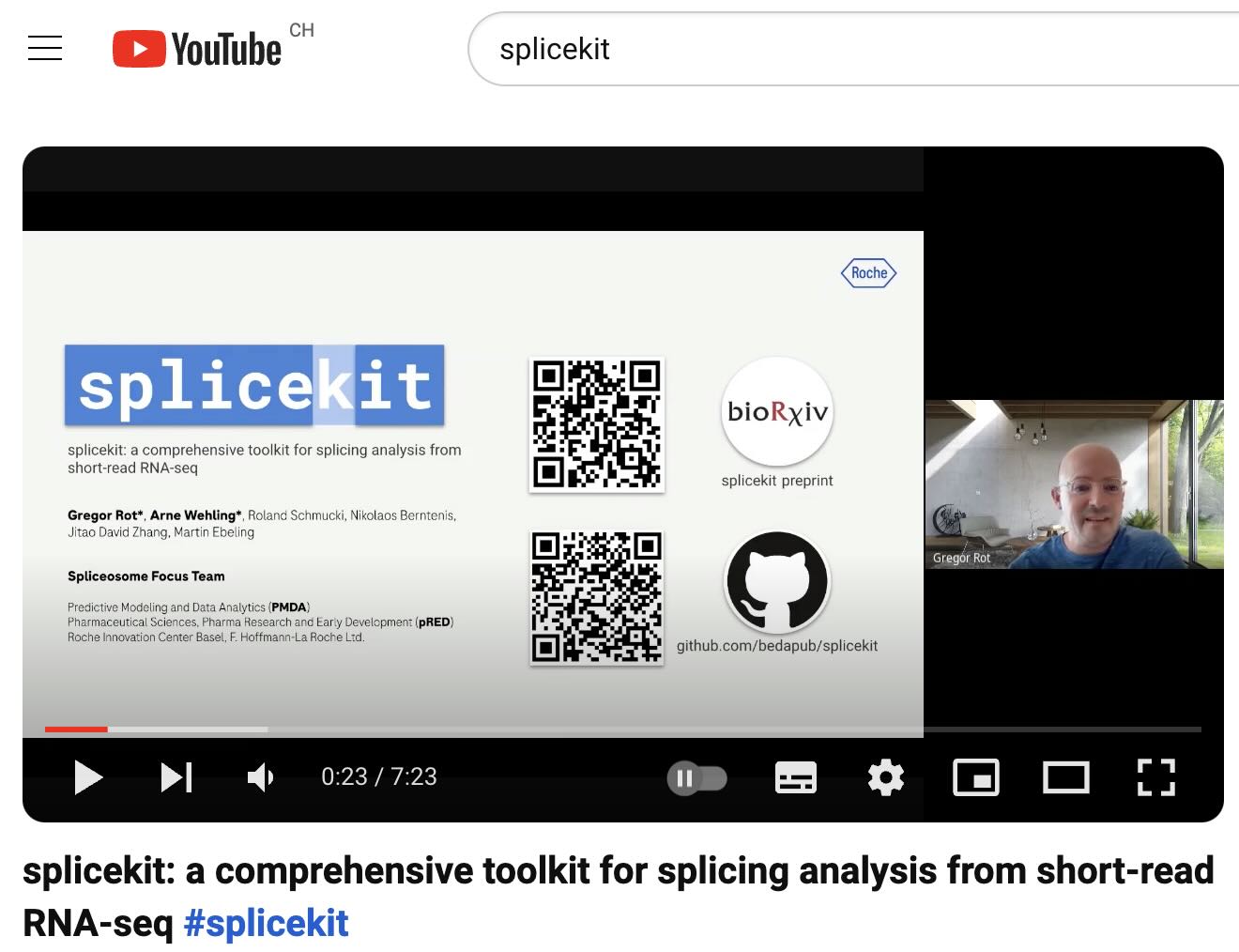
splicekit is a modular platform for splicing analysis from short-read RNA-seq datasets. The platform also integrates an JBrowse2 instance, pybio for genomic operations and scanRBP for RNA-protein binding studies. The whole analysis is self-contained (one single folder) and the platform is written in Python, in a modular way.
Check a short video presentation about splicekit (poster) at ECCB 2023 on Youtube:
The easiest way to install splicekit is to simply run:
$ pip install splicekit
Note that on some systems, pip is installing the executable scripts under ~/.local/bin. However this folder is not in the PATH which will result in command not found if you try to run $ splicekit on the command line. To fix this, please execute:
export PATH="$PATH:~/.local/bin"
Another suggestion is to install inside a virtual environment (using virtualenv).
Installing splicekit directly from the GitHub repository
pip install git+https://github.com/bedapub/splicekit.git@main
If you already have aligned reads in BAM files
All you need is samples.tab (note that this is a TAB delimited file) and splicekit.config in one folder (check datasets for examples).
You can easily download and prepare the reference genome (e.g. $ pybio genome homo_sapiens).
Finally run $ splicekit process (inside the folder with samples.tab and splicekit.config).
Easiest is to check datasets examples to see how the above files look like and also to check scripts if you need to map reads from FASTQ files with pybio.
- PDF reference manual
- Google docs of the above PDF (comment if you like)
v0.6: released in April 2024
- updated reports
- JUNE analysis (junction-events to classify skipped and mutually exclusive exons)
Past changenotes (click to view)
v0.4.9: released in November 2023
- added rMATS analysis for splicing events
- added Docker container that can be directly imported to singularity via ghcr.io
- fixed dependencies
- other small fixes
v0.4: released in May 2023
- added singularity container with all dependencies
- added local integrated JBrowse2
- cluster or desktop runs
- scanRBP and bootstrap analysis of RNA-protein binding
- further development and integration with pybio
- extended documentation of concepts, analysis and results
v0.3: released in January 2023 (click to show details)
- re-coded junction analysis
- independent junctions parsing from provided bam files
- master table of all junctions in the samples of the analyzed project, including novel junctions (refseq/ensembl non-annotated)
- clustering by logFC of pairwise-comparisons with dendrogram: junction, exon and gene levels (clusterlogfc module)
- added first_exon annotation for junctions touching annotated first exons of transcripts
- extended documentation of concepts, analysis and results
v0.2: released in October 2022
- software architecture restructure with python modules
- filtering of lowly expressed features by edgeR
- DonJuan analysis (junction-anchor analysis)
- more advanced motif analysis with DREME
- filtering regulated junctions with regulated donors
v0.1: released in July 2022
- initial version of splicekit
- parsing of junction and exon counts
- computing edgeR analysis from count tables and producing a results file with direct links to JBrowse2
- basic motif analysis
If you find splicekit useful in your work and research, please cite:
Rot, G., Wehling, A., Schmucki, R., Berntenis, N., Zhang, J. D., & Ebeling, M. (2024)
splicekit : an integrative toolkit for splicing analysis from short-read RNA-seq
Bioinformatics Advances, 4(1). https://doi.org/10.1093/bioadv/vbae121
In case of questions, issues and other ideas, please use the GitHub Issues or write directly to Gregor Rot.
